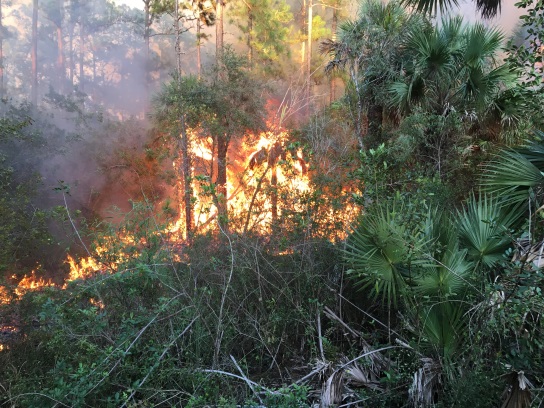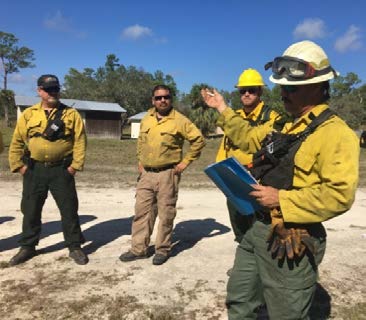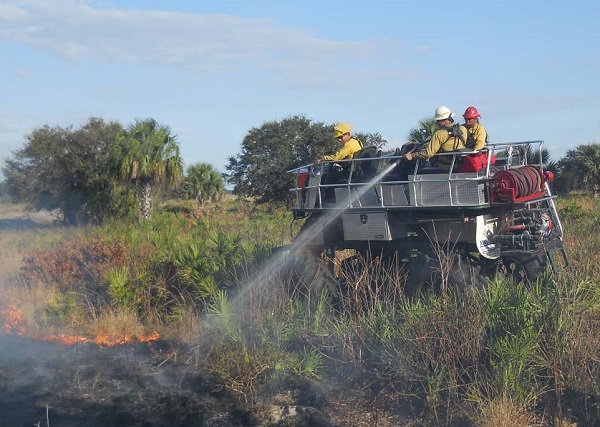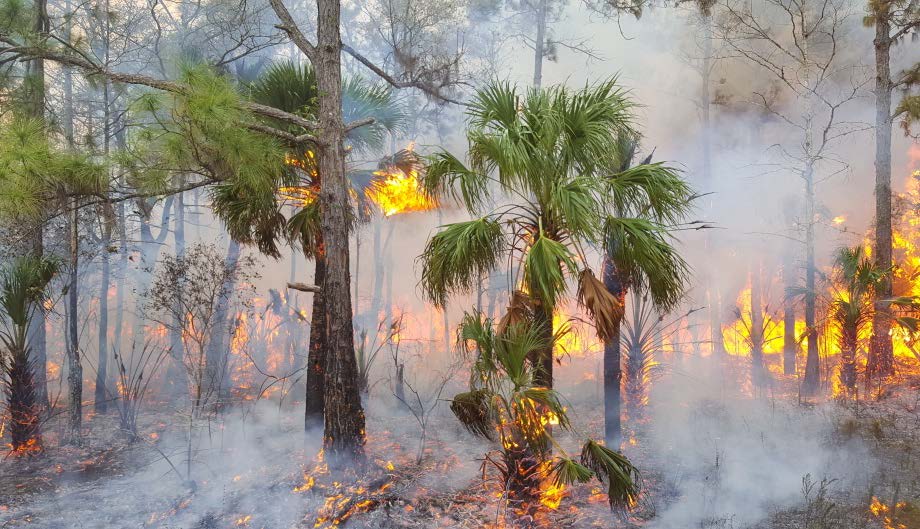You are viewing ARCHIVED content published online before January 20, 2025. Please note that this content is NOT UPDATED, and links may not work. Additionally, any previously issued diversity, equity, inclusion or gender-related guidance on this webpage should be considered rescinded.
Author: Robyn Broyles
Seminole Tribe of Florida is witnessing tremendous landscape changes taking place across their landscapes that have endangered their cultural practices and ways of life. Now, using a combination of fire and water, ecological and cultural balance is slowly returning.
In 1965 two canals were built that significantly altered the hydrology of the Seminole reservations. A depression in the landscape formed, lowering the water table. With lower water tables, plants were unable to hydrate or decompose organic material. Over time, upland plants began establishing in wetter places and new flora, such as pine trees, began establishing in lowland areas, choking out grass, cypress and other natural species the Seminole people depended on for medicinal and cultural uses.

Prescribe fire burning cabbage palm, palmetto and other desirable vegetation on Seminole Reservation, FL.
Furthermore, Florida receives more lightning than any other U.S. State, making wildfires a frequent and natural part of the landscape. Consequently, a complex network of grasslands, marshes, swamps, hardwood hammocks, cypress, pinelands and scrub adapted to fires. In addition, the Seminole people commonly used fire to make gathering cultural plants easier and to make travel possible through swamps. Due to early fire management policies that required firefighters extinguish any and all natural fires, flora dependent upon fire began overgrowing.
Without water or fire, the ecosystem grew out balance and function.
Working with the Natural Resource Conservation, National Park Service and Fish and Wildlife Service, Seminole Tribe is gaining ground in restoring their sensitive landscape, partially due to a complex network of canals and levees that now limit and redirect surface water flow. However, water alone will not restore the landscape.

Burn boss trainee conducts off site safety briefing prior to entry into burn unit.
On average, the Tribe treats over 10,000 acres a year to meet agricultural and ecological goals.
Applying fire every three to five years removes invasive plants and disease and allows fires to burn with less intensity. These lower intensity burns remove the understory, creating space for culturally important plants to establish. It also opens up the forest floor to allow wildlife to forage on new growth.
Applying fire improves the quantity, quality and access to important plants medicine women and men depend on for cultural and spiritual practices. It also removes vegetation that poses risk to Tribal infrastructure, homes, and safety.

Firefighters extinguish flames from a swamp buggy. An engine boss trainee provides oversight as part.
To meet this annual target, the Tribe needs the help of additional firefighters.
BIA assists the Seminole Tribe with meeting their land management goals by sending firefighters to Big Cypress and Brighton Reservation, a practice that has significant mutual benefits to firefighters across Indian Country.
The Seminole Tribe of Florida conducts prescribe burns 10-11 months of the year. This unusual fire regime proves ample opportunities for firefighters to work on necessary qualifications the fire community depends on to conduct safe and legal prescribe fires elsewhere.
Due to the large number of acres Seminole treats, the moderate complexity of each burn, and the fact that “every day is a burn day,” BIA views Seminole Tribal lands as an ideal location to train firefighters and provide opportunities to increase their fire management skills.
Seminole Tribe provides the training environment and housing for firefighters while BIA provides the trainees and funding to conduct the burns.
The number of firefighters fluctuates annually. This year, 12 firefighters from Indian Country will participate in one of three 14-day training sessions.
Safety is a product of experience; therefore, a key training goal is to provide repeated experiential learning opportunities that strengthen the confidence of fireline leaders. Trainees are responsible for designing burn units, writing appropriate burn plans, developing GIS maps, and coordinating with local agencies to apply for appropriate permits.
All trainees practice leading, either as a firing boss, holding boss, or burn boss. There is also emphasis on providing briefings, After Action Reviews, and radio communications throughout the assignment. The more experience a person has laying fire on the ground, reading fire behavior, understanding weather, adjusting ignition tactics to achieve objectives, and communicating intent to subordinates, the safer trainees becomes. As a whole, the experience demonstrates to students that large acreages can be treated safety and often quickly, achieving short and long-term ecological benefits. This experience builds confidence and a productivity-minded attitude that students then transfer to their home units.
This year, the Tribe’s goal is to burn 15,000 acres, in addition to using mechanical treatments to protect structures where wildland and urban areas interface.
This year, firefighters on detail have help treat nearly 6,300 acres. Detailers have also assisted with two wildfires, further enhancing suppression skills to their training experience.
The cost to accomplish this pays in economical, ecological and cultural dividends.
It is much cheaper to conduct prescribed fires in Florida than to react to them when conditions and locations are not ideal.
The economic cost to conduct a prescribe fire is about $42.00 per acre. The labor cost for four trainees a day is about $1,000. Given the average size of Seminole’s wildfires is about 50 acres, the cost to burn this same acreage is about $3,100/ day.
The cost to suppress a wildfire, which requires additional equipment, personnel and resources than a prescribed fire, may range between $8,000- $10,000 a day, depending on what the fire threatens.
Perhaps the greatest success to having fire and water being restored to a more natural balance is that the Seminole medicine women and men are seeing a return of their cultural practices. Medicinal herbs are being found in places not seen in a generation, and elders are noticing a return of wildlife that hasn’t been resent in their lifetimes.
For Immediate Release: March 1, 2017


